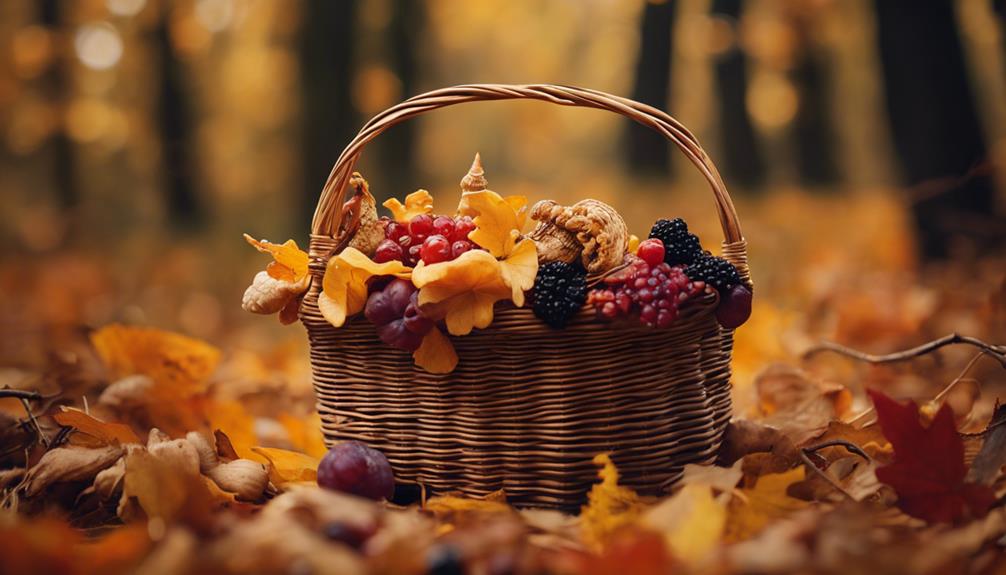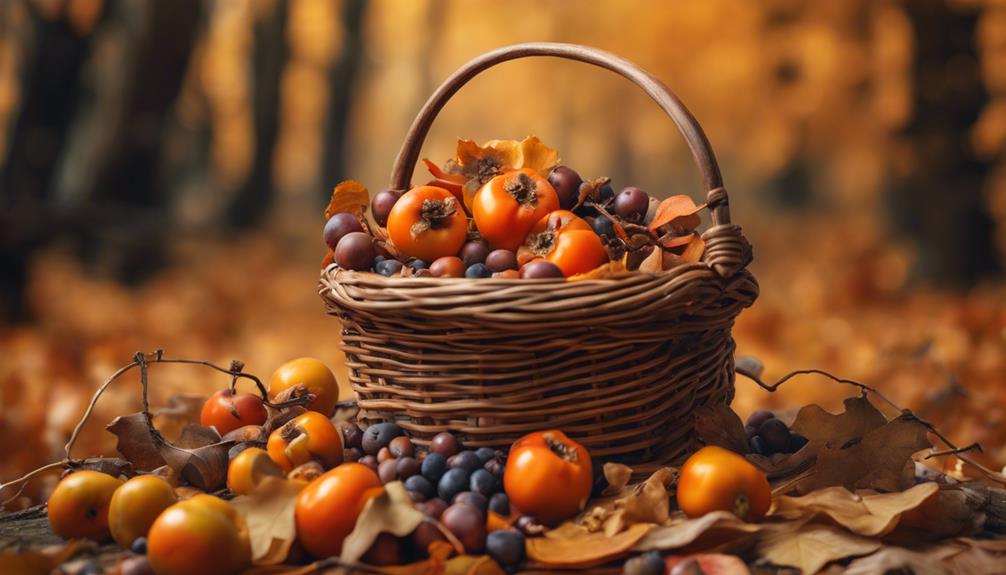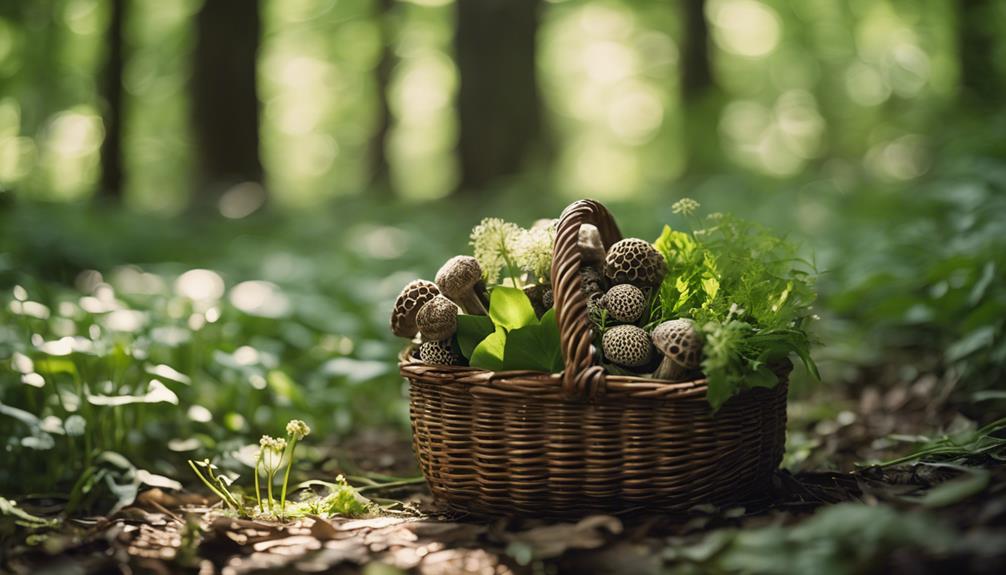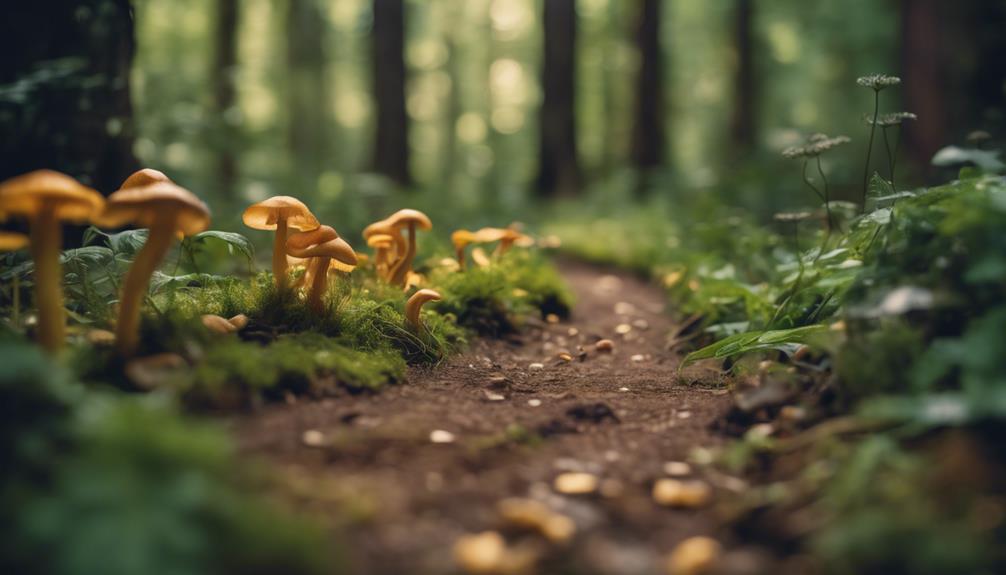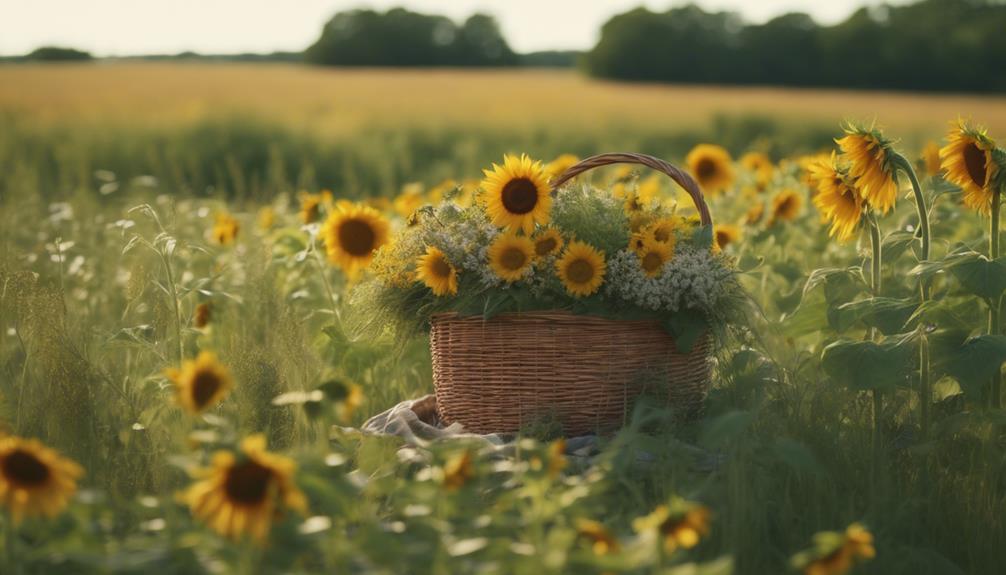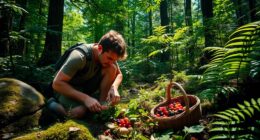You're about to discover the hidden gems of Massachusetts' wilderness, where wild grapes, beach plums, and Chicken of the Woods mushrooms await discovery in the coastal areas, forests, and fields of the Bay State. From exploring coastal areas for wild grapes and beach plums to venturing inland for rose hips and acorns, Massachusetts offers a diverse range of wild edibles. But before you start foraging, remember to positively identify plants, treat them with care, and pick them in moderation to preserve the ecosystem. Now, get ready to reveal the secrets of Massachusetts' wild edibles and discover the wonders that await you.
Key Takeaways
- Massachusetts offers a variety of wild edibles from coastal to inland regions, including grapes, American Sea-Rocket, and beach plums.
- Positively identifying plants before foraging is crucial to avoid risks, and respecting the ecosystem ensures a safe and sustainable experience.
- Mastering plant identification is essential for safe foraging, and utilizing expert guides and step-by-step testing methods can enhance skills.
- Wild edibles in Massachusetts are rich in antioxidants, protecting cells from damage, and can contribute to a diverse and nutrient-packed diet.
- Foraging responsibly in Massachusetts requires respecting the land, identifying plants correctly, and exercising caution to avoid misidentification and poisoning.
Massachusetts Wild Edibles Hotspots
Explore the coastal areas of Massachusetts, where you can stumble upon an abundance of wild grapes and American Sea-Rocket, or venture inland to uncover hidden gems like rose hips and acorns.
The state's diverse landscape offers a treasure trove of wild edibles waiting to be discovered. Beach plums, for instance, can be found along the coastal dunes, while inland, you can forage for rose hips, rich in vitamin C, perfect for tea or raw consumption.
Massachusetts' unique combination of coastal and inland regions creates an ideal environment for a wide range of wild edibles to thrive. From the coastal areas to the inland woods, the state is a forager's paradise.
As you explore the state's wild landscapes, keep an eye out for other edible treasures like elderberries, black chokeberries, and Chicken of the Woods mushrooms. With a little knowledge and preparation, you can uncover the secrets of Massachusetts' wild edibles and enjoy the bounty of the state's natural landscape.
Responsible Foraging Practices 101

As you venture into the world of foraging, it's important that you master the art of responsible foraging practices to guarantee a safe and sustainable experience. You're not just picking wild edibles, you're building a connection with nature. To ensure this connection flourishes, follow these essential guidelines:
| Responsible Foraging Practices | Why It Matters |
|---|---|
| Positively identify plants before foraging | Avoid potential risks and secure a safe experience |
| Treat harvested plants with care | Respect the living beings you're working with |
| Pick plants carefully and in moderation | Preserve the ecosystem for future generations |
| Express gratitude for the plants | Cultivate a mindful and respectful attitude |
Plant Identification Mastery

Now that you've committed to responsible foraging practices, it's time to develop the skills to back them up, starting with mastering plant identification. This important step ensures you can confidently identify edible plants and avoid potential risks.
According to foraging expert Nick Spero, positive plant identification is essential to safe and successful foraging. To enhance your plant identification skills, utilize resources like expert guides and step-by-step testing methods. As you hone your skills through practice and learning from experienced foragers, you'll become proficient in identifying edible plants.
Remember, mastery of plant identification is key to a successful foraging experience. By dedicating time to develop this skill, you'll be able to venture out into the wild with confidence, knowing you can identify the plants that are safe to eat.
With practice and patience, you'll discover the secrets of Massachusetts' wild edibles, and your foraging adventures will become more rewarding and enjoyable. As your understanding grows, you’ll begin to recognize nutritious plants such as wild berries, mushrooms, and edible greens native to the region. Whether you’re exploring local forests or coastal areas, always remember to forage responsibly by identifying plants properly and leaving enough for wildlife. If you plan to venture beyond Massachusetts, many of the same principles can apply, and seeking out foraging tips in Pennsylvania can enhance your skills in diverse ecosystems across state lines.
Nutritional Benefits of Wild Edibles

As you explore the world of wild edibles, you'll discover a treasure trove of nutritional benefits.
You'll find that these foraged foods are rich in antioxidants, which help protect your cells from damage, and packed with fiber, which supports healthy digestion.
Rich in Antioxidants
By incorporating wild edibles into your diet, you'll reap the benefits of a rich antioxidant intake, which helps combat oxidative stress and reduce inflammation in your body. Wild plants, in particular, are packed with antioxidants that can help protect your cells from damage and promote longevity and vitality.
For example, wild berries like blueberries and raspberries are rich in antioxidants like anthocyanins and ellagic acid, which have been shown to have anti-inflammatory properties.
Consuming wild edibles can contribute to a diverse and nutrient-packed diet, enhancing your body's natural defense systems. By including wild edibles in your diet, you'll not only get a boost of antioxidants but also support your overall health and well-being.
Plus, foraging for wild edibles is a sustainable and environmentally friendly way to get the nutrients you need. So, take advantage of Massachusetts' wild edibles and start reaping the benefits of a rich antioxidant intake today!
Packed With Fiber
You'll be delighted to discover that many wild edibles are exceptionally high in fiber, making them a nutritional powerhouse for your digestive health. Incorporating these wild plants into your diet can increase your fiber intake, aiding in weight management and reducing cholesterol levels. This is especially important since many people don't consume enough fiber in their daily diet.
Here are some key benefits of consuming wild edibles packed with fiber:
- Regulates Blood Sugar Levels: Soluble and insoluble fiber in wild edibles helps regulate blood sugar levels and maintain gut health.
- Promotes Satiety: The high fiber content in wild edibles can help prevent constipation and promote overall digestive wellness.
- Supports Healthy Digestion: Fiber-rich wild edibles contribute to a balanced and nutritious diet, supporting overall health and well-being.
- Aids in Weight Management: Increasing your fiber intake through wild edibles can aid in weight management and reduce cholesterol levels.
Seasonal Foraging in Massachusetts

As you explore the world of foraging in Massachusetts, you'll discover that each season brings its own unique bounty of wild edibles.
From spring's vibrant greens to summer's juicy fruits, autumn's nuts and mushrooms, and winter's coniferous treats, the Bay State has something to offer year-round.
Spring Into Wild Greens
In central Massachusetts, the spring season reveals a vibrant tapestry of wild edibles, with ramps, watercress, fiddleheads, and violets waiting to be discovered. As you begin your foraging journey, you'll find a diverse landscape that's ripe for exploration.
This is the perfect time to indulge in wild greens like dandelion greens, lamb's quarters, and wood sorrel, which are abundant during the spring season.
To guarantee sustainable foraging practices, remember:
- Harvest responsibly: Avoid over-picking to maintain wild plant populations.
- Identify correctly: Make sure you've got the right plant to avoid mistakenly picking something inedible or toxic.
- Respect the land: Always forage on public land or with private landowner permission.
- Keep it clean: Avoid areas that may have been contaminated with pesticides, heavy metals, or other pollutants.
Summer Fruits Abound
Summer's warmth brings a colorful array of fruits to forage in Massachusetts, where blackberries, raspberries, strawberries, and elderberries ripen in the wild.
As you venture out, you'll discover that summer is the prime time to gather native fruits from the wild. You'll find an abundance of wild edibles, including blackberries, raspberries, strawberries, and elderberries, ripe for the picking. These fruits aren't only delicious but also packed with nutrients.
Foraging in Massachusetts during the summer months offers more than just fruits. You can also find edible cattails, oyster mushrooms, and cattail rhizomes to add to your harvest.
As you explore the outdoors, remember to always identify what you've found correctly and harvest responsibly to maintain the ecosystem's balance. With a little practice and patience, you'll be enjoying the sweet taste of summer's wild edibles in no time.
Common Misconceptions Debunked

You may have heard that foraging is illegal in Massachusetts, but that's just one of the many misconceptions surrounding this practice. In reality, foraging is legal in Massachusetts state forests as long as you don't damage the environment. You just need to be mindful of private property and obtain permission before foraging.
Here are some common misconceptions debunked:
- Foraging is illegal: As mentioned, foraging is legal in state forests, and with permission, on private property.
- Foraging harms the environment: On the contrary, foraging responsibly can actually help preserve natural ecosystems.
- There's nothing edible in Massachusetts: Massachusetts has a diverse range of wild edibles, including mushrooms, berries, and herbs.
- Anyone can forage: Learning to positively identify plants and fungi is essential to safe and successful foraging in Massachusetts.
Foraging Safety Guidelines

When venturing into Massachusetts' woods, it's important to prioritize safety and exercise caution when foraging for wild edibles. As you explore the world of foraging, it's vital to remember that some plants and fungi can be toxic or even deadly if ingested.
To guarantee a safe and enjoyable foraging experience, always positively identify the plants you find before consuming them. Don't rely on guesswork or assumptions – expert guidance is key to preventing misidentification and potential poisoning.
When trying new plants, start with small amounts to test for adverse reactions. Practice responsible foraging by picking plants carefully and with gratitude. Seek out experienced foragers or reliable resources for accurate plant identification and safe foraging practices.
Frequently Asked Questions
How Do You Forage Wild Edibles?
You start by researching edible species, then head outdoors to identify and collect them, following safety guidelines and sustainable practices to guarantee a fun and responsible foraging experience, connecting you with nature and its bounty.
What Is the Number One Rule of Foraging?
"When venturing into the wild, remember, you're not a culinary pioneer, discovering new flavors by trial and error – you're a responsible forager, and the number one rule is to positively identify plants before consumption, no exceptions!"
How Do You Know if Something Is Edible in the Wild?
You verify a plant's edibility by positively identifying it, consulting experts like Nick Spero or Samuel Thayer, and conducting small-scale taste tests and skin/oral tests to rule out adverse reactions.
What Should You Avoid When Foraging?
When foraging, you should avoid areas with heavy pollution, pesticide use, or roadsides, as they can contaminate your finds. You should also steer clear of toxic look-alikes, unknown species, and plants with known toxic properties.
Conclusion
You've got the skills, you've got the knowledge, and you've got the thrill of the hunt. Now, get ready to uncover the secrets of Massachusetts' wild edibles.
As you venture into the unknown, remember to stay vigilant, stay curious, and stay responsible. The forest is full of surprises, and with every step, you're one step closer to discovering the untapped flavors and nutrients of the wild.
The adventure begins – will you take the first bite?

